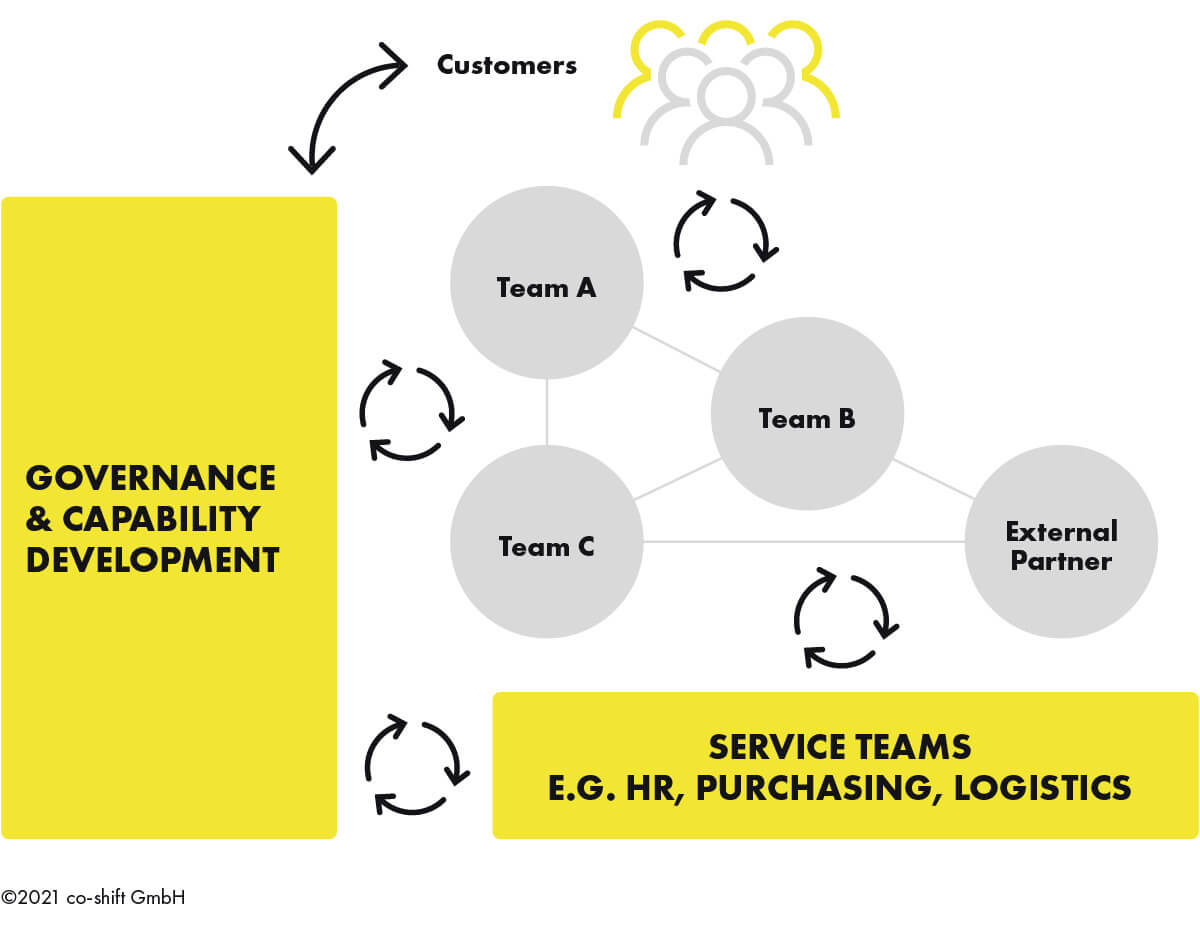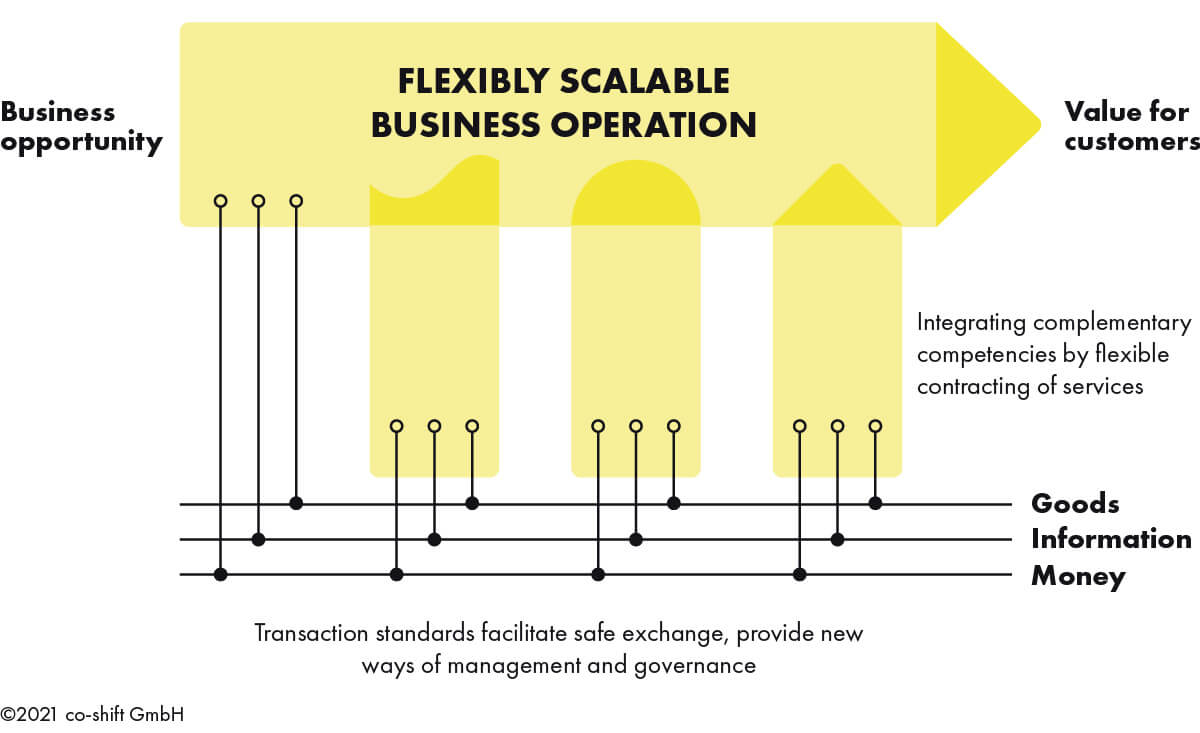Growing opportunity
Janka Krings-Klebe and Jörg Schreiner
The rise of digital technology has fundamentally changed the way how business works. Businesses today compete and cooperate through digital channels on a global scale. In such a globally interconnected world, flexibility, speed and adaptability are in high demand. These traits provide the cornerstone for customer-directed innovation at speed and scale. Digital business ecosystems have proven to be a very powerful – if not the most powerful – innovation setup known today.
Roughly twenty years ago, Nvidia emerged as the leading company for graphical processing chip sets, mostly used for gaming platforms, PCs and mobile computing devices. It turned out that some of their chips were also perfect hardware platforms for machine learning applications. Nvidia was quick to enter this market, soon supplying Tesla and other companies with customized hardware for their cars, thereby taking autonomous driving to the next level and making Nvidia more independent from the declining PC market.
The challenge for companies in dynamic markets is not to launch innovative products like this once every few years. It is to do it all the time. Amazon does so. Haier does so as do companies including Nucor, Handelsbanken and Morning Star. These organizations have a thirst for innovation at the core of their business. They always look to improve their operations and to increase the value they can provide for customers. Their organizational structure perfectly reflects this habit (see Figure 1) with autonomous teams working closely with the demands of customers. They can easily create a new business to meet an emerging opportunity. The whole organization is dedicated to continuously starting, operating and closing multiple business operations.

These innovative organizations work like an ecosystem, all parts competing and cooperating at the same time in a business setup that fosters flexibility, speed and customer-directed innovation.
How to create such a business setup? How can traditional organizations transform into something similarly powerful? Companies like Haier and Amazon show the way to do it: corporations have to internally transform their operations into a highly dynamic ecosystem and learn to manage and govern every part of this setup according to principles of adaptivity. This is a fundamental organizational requirement to successfully take part in business ecosystems. It must become part of an organization’s DNA. Companies lacking this ability cannot hope to profit from ecosystems.
From hierarchy to ecosystem
Looking at how business was done for decades and still is, you usually find an efficiency driven monoculture. Most business organizations focus on efficiently producing a limited number of different products for a stable market. Innovation in this context means incrementally improving on existing products or operations. Processes and structures typically emerge according to the needs of the dominant business. IP-management, risk management, financing and staffing of operations are perfect examples. These are by their very nature self-limiting. Today, companies follow governance principles that simply leave no room to quickly act in constantly changing market environments. These management practices, optimized over decades to serve one dominant business, are road blocks to taking part in ecosystems. They limit the available space for new or deviating business. Those outlying business opportunities are not welcome, as they disturb the main business and reduce short-term revenue. That is why moon-shot innovation or new business opportunities are usually strictly separated from a company’s main business.
Over decades, this strategy worked well due to stable market conditions. But in a hyper-dynamic environment with multiple players in the market, a strategy of putting all your eggs into a single basket and taking every effort to protect this basket for a long time, becomes increasingly dangerous. It is a road block for adaptation and taking part in business ecosystems.
Is there a way to reverse this strategy? Of course, there is. Handelsbanken, Nucor, and Haier all have followed this way for their impressive transformations. Corporations need to learn to manage and govern all their operations according to market-based principles of adaptivity to customer needs and innovation opportunities. These market-based principles can be applied to internal operations, thereby changing all management and governance practices.
Learning to do this is the most important step in this journey. Corporations cannot skip it and there is no shortcut. This step is crucial for succeeding in the transformation and to establish corporate learning. In practice, this means starting small with a few teams, learning fast, removing emerging barriers, and changing processes and structures to better align with market needs. New-found practices then need to rapidly find their way to all places in the organization where they add value. Developing flexible business practices in such a gradual approach has proven to be a successful path for transformation efforts. With this first step, corporations can achieve remarkable adaptation and innovation capabilities. The constant alignment of structures and processes with customer needs ensures that the corporation stays relevant. Being able to perform this alignment at high speeds and in multiple spots at the same time then feels like the company fluidly adapts to emergent customers, business opportunities and market needs. It is a perfect organizational setup for participation in cross-company ecosystems and a prerequisite for starting ecosystems. Companies must not even think about ecosystems if they lack this flexibility.
With flexible cooperation practices in place, joint business across companies becomes much easier. Extending these flexible practices to accommodate new external partners is simple. At this point, ecosystems can fully leverage their strengths for the participants to quickly take advantage of emerging business opportunities.
Decoding business ecosystems
The most powerful ecosystems are set up as an open marketplace, thereby breaking down a crucial barrier to innovation: They are unlimited in the resources and business capabilities they can provide to their customers. Marketplaces can unlock resources and services that are traditionally locked inside a single business operation and make them available to many other business operations.
The organizational structure of these ecosystem setups constantly and fluidly matches resources and capabilities to new opportunities. It makes them incredible fast, flexible, and able to perform very well across a wide field of vastly different business operations.
It is an organizational structure based on principles of entrepreneurial autonomy and reusable services, largely aligned through digital interfaces. Amazon and Haier work like marketplaces of business services on a common digital transaction platform. Business operations can quickly be set up by combining customized front-end operations with standardized back-end services. These back-end services are readily available for any kind of business operation. They offer a comprehensive catalogue of basic services, like accounting, cloud storage, invoicing, payment, or shipping, that every business operation needs. They also offer a lot of specialized and unique services, such as Amazon Wallet or Haier’s open R&D partnership ecosystem Hope. Each service in essence provides a high-performing business capability, that can easily be integrated into many kinds of business operations. Combined, this business architecture can quickly gain track across a wide spectrum of markets or industries. It can explore many more business opportunities in parallel than traditional businesses. It can scale up profitable business operations much faster. It can very easily establish a system of distributed control and management that is much more efficient than traditional organizational structures.
Business operations in such platforms can quickly scale up or down and adapt to new demands and opportunities. They can easily acquire and integrate new competencies and resources. They give access to competencies and services that would otherwise be too hard or too costly to build. They can provide limitless opportunities to entrepreneurs and innovators. They can considerably bring down the risks traditionally associated with starting a new business operation.
The following scenario shows how ecosystems can elevate entrepreneurship to the next level.
Sally’s story
An entrepreneur, let’s call her Sally, has spotted a business opportunity, and she has an idea how to turn it into a product. She can easily acquire all lacking competencies for her new business operation at fair and flexible conditions through services of partners in the ecosystem: From seed financing, prototype development, purchase of materials, targeted marketing campaigns, to all kinds of development and manufacturing competencies, sales, logistics, branding and accounting. All these functions and competences of a business are available to Sally through digital channels and standardized transactions, including contracting and payment. Sally has full transparency about the offered services and can easily pick the competencies that she needs.
The platform powering the ecosystem makes these competences quickly available as a service for her business operation. The platform’s business design and operation tool set allow her to quickly design the insides of her business operation as a sequence of integrated services and contracts delivering value to customers. Standardized digital transaction protocols and contract templates facilitate the execution of the contracts. They ensure that all participants in the ecosystem can exchange money, goods, and information at fair, safe, and secure conditions. Digital contracts and transaction records are automatically logged in a tamper-proof way, thus promoting trust among participants in the ecosystem.
The business design and operation tool set of the platform, its contracting options and standardized transaction protocols enable Sally to fully control the design of her business operation, to monitor its performance, to make adjustments where necessary, and to quickly reproduce, scale and adapt it for different customer groups. In short, digital tools facilitate and automate many managerial tasks of Sally. They are as easy to use as digital project management and workflow tools, but are for more powerful and adaptable, able to automate many tasks and transactions. They support her in every business phase: From inception to operation, growth, diversification and finally closure or sale of the business.
For Sally, this means she can start her business operation small, experiment and incrementally adapt her products’ value to customer needs. If successful, she can quickly scale her operations up and down according to demand. Sally can focus her efforts on delivering value to her customers, and flexibly adapt her business to excel in its purpose. She can take on more risks, because she doesn’t need to build up all competencies with her own resources. Much of the needed resources and capabilities are quickly and easily available in the ecosystem. She can even spin off parts of her business operation as a service to other participants in the ecosystem, thus contributing to its overall strength.
Designing highly adaptive business ecosystems
The basic design of a business operation in a business ecosystem is a combination of services delivering value to customers (Figure 2). All parts of the business operation exchange goods, money and information through the digital transaction protocols of the ecosystem. Any service in this ecosystem can also be regarded as its own business operation, performing value for others. It can also contract other services. In this way, business operations can become aggregated into more complex services. They can take on the kind of complex business challenges typically performed by large corporations. Despite the resulting size and complexity, such operations can remain similar fast and flexible than a startup, because the digital transaction backbone provides excellent data about markets and business operations in real time, enabling excellent control of large-scale and complex operations. It goes far beyond the levels of control that hierarchical reporting lines and traditional controlling functions can achieve. The digital backbone provides control and feedback loops that work in real-time, and which can largely be automated and facilitated by digital assistants.

Designing the governance of digitally facilitated ecosystems
In business ecosystems, the majority of decisions are made at the edges, at the point with the biggest impact, usually very close to customers. It is essential to give up control at these edges, and to learn from constant experimentation how to make the most of each new challenge and opportunity. Giving up control at the edges doesn’t mean giving up all means of governance and control inside digitally facilitated business ecosystems. Indeed, the reverse is the case.
The digital technology powering them is also a quick multiplier for all effects that their business operations have. They can affect single business operations, bigger clusters of business operations, the ecosystem itself or even the surrounding economy and society – for good and for bad. Balancing the interests of business owners with the long-term interests of other stakeholders therefore is more important than ever in a world dominated by digitally facilitated ecosystems.
The digital transaction records in the ecosystem provide efficient means of governance. They contain valuable and tamper-proof information about the ecosystem participants, their areas of business, services performed, emerging trends and issues. All this information is available in real time, giving ecosystem managers timely insights into associated parts of the local economy. They can use these insights to improve the digital tools in the ecosystem, making it more powerful and attractive.
More importantly, they can be used to execute efficient governance on different levels:
- They can direct economic activity towards alignment with local and national policies.
- They can balance legitimate interests of different stakeholder groups.
- They can ultimately swiftly execute sanctions or legal actions against criminal, corrupt or unethical behavior in the ecosystem.
- Legal systems and jurisdiction for these business ecosystems ultimately need to be controlled by the societies in which they operate. It is crucial to have this kind of control in order to achieve a dynamic and fair balance of interests of all stakeholders affected by the ecosystems.
Looking at how current large businesses increasingly dominate economies, how they execute power over individuals, suppliers and also consumers, and how it becomes ever harder for small businesses to compete against these giants, we think it is high time to reverse this trend.
Every new participant, added business operation and service contributes to the growth of the ecosystem, its power to perform, and the impact it has on society and overall development of the economy. Monitoring and governance of its activities therefore becomes a necessity.
Governance of businesses determines the opportunities that people have in their jobs. Good governance and leadership in businesses can provide more, and better opportunities. It makes people happier in their jobs.
Politics has a crucial role to play here: it creates the legal and regulatory framework for business and entrepreneurship. It can shape this framework in such a way that companies also serve the interests of society. Politics can also ensure that the expansion of the digital economy creates sustainable opportunities for participation in all population groups.
Digital business ecosystems can contribute hugely to this vision: controlling access to digitally facilitated ecosystems and achieving control over the digital standards used for transactions in a digitally facilitated ecosystem gives leaders powerful new tools for governance. This power belongs in the hands of governments who work for the prosperity of society and the happiness of their people. They can use it to provide more, and better, opportunities for people in their organization to become successful entrepreneurs. Entrepreneurs, in turn, can share their success when their businesses contribute to improve the economic opportunities of millions of people.
Janka Krings-Klebe and Jörg Schreiner are founders and managing partners of co-shift GmbH, helping companies to transform into business ecosystems. Their latest book is Future Legends – Business in Hyper- Dynamic Markets (Tredition, 2017).


